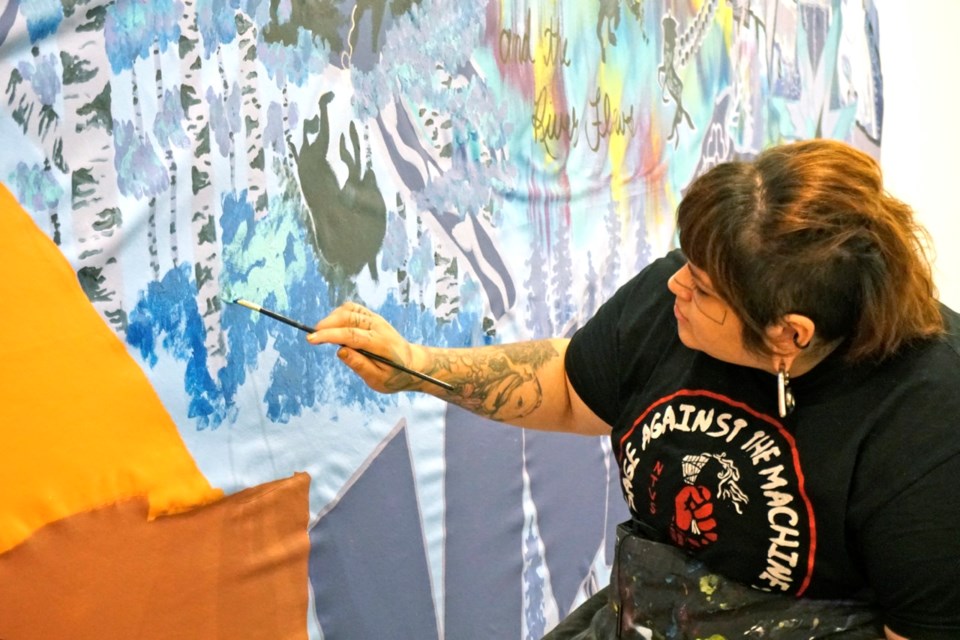ESTEVAN — The Estevan Art Gallery and Museum is currently hosting Reconcil-onialism – a mini residency dedicated to the creation of a mural by Cree-Métis artist Geanna Dunbar, who is based out of Regina.
For two weeks, Dunbar has been working on a mixed-media mural on canvas, telling a story of reconciliation in today's world.
"I wanted to showcase what it's like being Indigenous in the 21st century, and what reconciliation could be like without the aspects of colonialism," Dunbar shared in an interview with the Mercury and SaskToday.
"These days, we're going through a lot with the pipeline, and now we have our people taking on the government for [getting] land back and wanting mineral rights; there's a lot of stuff going on. It's quite a big movement that's been going on forever. And I just want to showcase what that can be like living with the fight, and then what the future can bring for us as Indigenous folks."
Dunbar said from the beginning, she wanted to have an image of a woman and a man as part of the mural.
"I feel that our women and children have suffered a lot throughout this cause and that it's time for our men to step up ... and to help us with the fight," Dunbar said. "Our modern-day world is run strongly by men; it's in their hands to make any systematic change. So, I think it's really important to see that in order for us to have that systematic change we have to make sure that there are no biases, and we really see what things are in the end."
The long mural that tells a story has two colour-distinctive halves – with one being warm-coloured and the other cool.
"One side represents the distress. And the other side represents the healing. And the centre represents the progression and what we need to have as it is in more of muted tones," Dunbar explained.
"We can say a lot through colours. It represents emotion a lot. It represents feeling. When people come into a certain colour room, they can feel a certain way. So, I wanted that to be incorporated into the painting as well; when people see it I want them to have that emotion ignited."
While Dunbar started with a plan, she said the piece is progressive and has been changing along the way.
"Once you get in there, things just change, the feeling of it changes. So, every day, I come in, and I'll have a plan, but on the fly, sometimes things will just change," Dunbar shared.
The two-week mini residency will come to an end with a meet and greet at the EAGM on Sept. 15 from 6:30-8:30 p.m. The finished mural will be on display for the public to see. There will be snacks, beverages and most importantly, a chance to meet with Dunbar and gain more insight into their exhibitions and studio practice.
From Sept. 8 through Nov. 10, the Gallery I also features Dunbar's exhibition Altar-native. These artworks are sacred altar-like mixed media pieces representing what Indigenous people sacrificed for the "gift" of a colonial god domination and the effects of this juxtaposition on Indigenous people, according to the artist's statement.
The effects are diverse and varied, depending on the context and region involved, and feature the loss or transformation of Indigenous cultures, languages and identities due to the imposition and conversion to Christianity and other colonial religions. These altars represent the emergence of new religious movements and reformations that took from Indigenous elements and were used in colonial spaces.
The exhibition showcases the movement of resistance and rebellion against colonial oppression, exploitation and discrimination against Indigenous peoples. These effects are still relevant in many societies today as they shape different regions, says the statement.
Every altar features traditional offerings gifted through the resurgence of Indigenous tattoo, medicines of natural elements found, purchased and offered from Treaty 1, Treaty 4, Treaty 6, Treaty 7, the Cowessess First Nation and New Brunswick (the home of Mi'gmaq, the Wolastoqiyik and the Peskotomuhkati people along the Saint John River Valley) and items from Tyendinaga Mohawk Territory.
"These altars are for our ancestors who were raped of everything they practised – language, culture, spirituality, so colonizers could make space for their gods and way of life," says the artist statement.
Reconcil-onialism is a work that echoes the pieces from Altar-native. Where Altar-native shows the past and present, Reconcil-onialism shows the present and future.
"Reconciliation by religious definition is the end of estrangement, caused by original sin, between God and humanity," reads the statement. "As we enter a new era of 'Truth and Reconciliation', we must acknowledge the heavy irony and virtue signalling brought on by religion, by government and white spaces. This residency was influenced through my work with elder Brenda Dubois on the project The Path to Reconciliation, located on Scarth Street Mall in Regina, Saskatchewan. She told me:
"'We cannot have reconciliation without first acknowledging the truth. We can't have reconciliation without resurgence, reclamation, reciprocity and the capacity to evolve and make systematic change.'"


